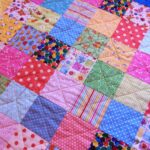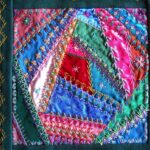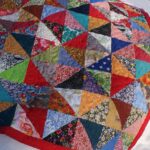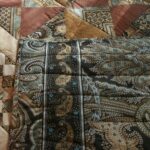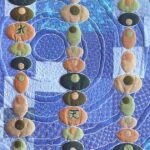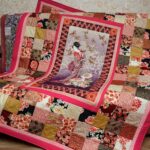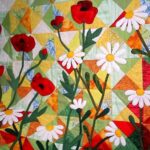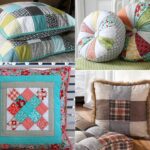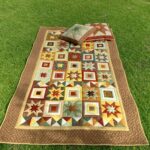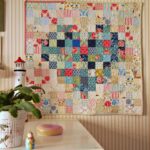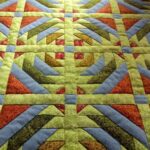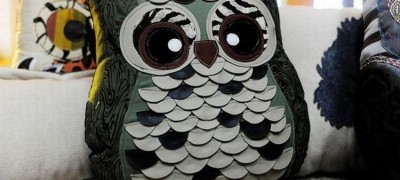How to sew a patchwork bedspread with your own hands
The patchwork quilt first appeared in the 11th century. England is considered the homeland. But similar hand-made products were sewn at different times in Russia, Europe, USA, Australia. Sewing from rags sometimes loses its relevance, then again becomes a trend.
How to sew a DIY patchwork quilt
Now the patchwork bedspread is again at the peak of its popularity. After reading our article, you will learn how to sew a patchwork quilt with your own hands: step by step instructions are included.
Choice of design
Externally, a patchwork plaid looks beautiful and looks like a variegated mosaic. Some people prefer to pick up pieces of fabric on a whim. But more often the pattern has a clear symmetry, sometimes the pattern is very complex and is only suitable for experienced patchwork craftsmen.

When creating a design, it is important to choose the right colors. To do this, you can use the rules of the color wheel. Another option is to use a material of three colors and three patterns. The main canvas is chosen not in a bright color, and the rest of the shades contrast against its background.
Rules for choosing a pattern on patches:
- It is better to exclude excessively bright patterns and colors - they will dazzle in the eyes.
- Fold in advance the flaps that have not yet been sewn into the canvas in order to understand the big picture.
- It is better to choose a large pattern of a monochromatic shade in a bright range than small patches with small patterns and in different colors.

Advice! If you can't find the colors yourself, you can use a special program on the Internet. It will help you automatically select shades that match well.
Choice of tools
For sewing a quilt from rags, not so many materials and tools are needed. Almost all of them are available to those who are engaged in sewing at least a little.

You will need:
- Scissors. It is necessary to stock up on large tailor's scissors for cutting large cuts of fabric. You also need small scissors to remove the threads.
- Fabrics. Most often, fabrics are taken that do not stretch. These include: cotton, satin, calico, chintz.
- Pins. You will need safety pins or thin ones with large ears. They are needed to hold the pieces of fabric together. They will also be required to join the layers of the bedspread before quilting.
- Threads. The choice of thread number depends on the thickness of the fabric. But most often threads # 45 or # 50 are used.
- Filler. Usually a patchwork quilt has 3 layers. The first is patchwork. The second is the layer. The third is the back of the bedspread, which is often called the back. Often, the backing is made in a single color, in harmony with the overall color scheme of the interior. The second layer is the filler. Different materials can act as it: cotton batting, synthetic winterizer, patchwork fillers. The filler can be a regular woolen blanket. It is covered with fabric on both sides and gets a second life thanks to the patchwork technique.
- Fabric markers. You will need it to mark the fabric into squares. There are several types of markers. Double-sided: one side draws, the other erases. Aqua markers: drawn lines disappear after washing the garment.Markers whose lines disappear for 1-3 days.
- Sewing machine. A patchwork bedspread is difficult to sew without a sewing machine. Any machine will do: with a hand, foot drive. The main thing is that it is well tuned, does not perforate the fabric and does not tear the threads when sewing.
- Iron. For sewn pieces of material, it is imperative to smooth out the seams well. Otherwise, the finished blanket will bulge and look not presentable.
Selection and calculation of material
Sewing a blanket from scraps of fabric with your own hands is not difficult at all. But it is important to initially correctly calculate the required amount of materials. A blanket made of rags is made according to the following scheme:
- Indicate for yourself what size the blanket will be. Suppose its dimensions are classic - 1.5 x 2.3 m.
- Choose a color scheme. Let's say it will be a lavender-brown scale.
- Decide on the sewing technique. The easiest one is to assemble a blanket from squares.
- Cut the pieces of fabric into equal squares. Their number should correspond to the size of the blanket. For example, for a blanket of 1.5 x 2.3 m, you need 345 squares measuring 10 x 10 cm.
- When cutting, make an indent of 0.5-1 cm on each side of the square. It is necessary for the line. If you do not do it, the squares, like the blanket itself, will become smaller in size than originally intended.
- Cut out the back: cut a rectangle 1.5 x 2.3 m from a plain fabric, in our case brown or lavender.
- Make seam allowances on each side of 1.5-2 cm.
- On a notebook sheet in a cage, create a sketch of the future blanket. You can use colored pencils to visualize your design more clearly.

Blanket making process
After developing the design, selecting materials and tools, calculating the fabric, you can start sewing. For beginners, the simplest technique is suitable - connecting identical squares into a canvas. The process of creating a blanket looks like this: cutting, patchwork, assembly.
Sewing
As already mentioned, the patchwork blanket consists of three parts: the front one from pieces of fabric, the inner filler and the backing - the back side. All of them are cut out in accordance with the size of the blanket. The cutting process looks like this:
- Following the scheme, cut out the required number of squares, making seam allowances on all sides.
- Cut out the backing, make seam allowances on each side.
- Cut the filler to fit the quilt.

Patchwork sewing
After all the parts are cut out, you can start assembling them. Even a beginner can handle patchwork from the same squares. You just need to be able to sew a straight line on a sewing machine.
Step-by-step sewing instructions:
- Iron the cut flaps thoroughly.
- Sweep the required number of squares on the sides to form a strip.
- At the same time, the squares are applied to each other face to face, swept away from the seamy side.
- Sew the squares on a typewriter, smooth the seams from the inside out.
Important! The seams are ironed "flattened": with the tip of the iron in different directions. If squares of fabric of different density are used, then the seam is smoothed towards the denser fabric.
- Then sew the resulting strips together to form a solid canvas.
- Now fold all the parts of the future bedspread like a layer cake. The first layer is filler. The second is a bedspread sewn from rags. It is placed face up on the filler. The third layer is a backing, which is placed face-down on a stack of patchwork and filler. It turns out that the patchwork part and the back are folded face to face.
- After the "puff" is folded, a line is made around the entire perimeter of the blanket. A hole is left at the top or side through which the blanket can be turned out.
- Unscrew the blanket. The backing material should remain inside the puff pastry. Above - the front patchwork part and the one-color reverse side of the bedspread.
- Carefully close the hole through which the coverlet was turned out with a needle and thread.
Advice! If you are not sure whether the "puff" is correctly folded, you can first sweep all layers and turn them out. Then, if everything is in order, turn the product out again on the wrong side and sew the seams on a typewriter.
To prevent the lining from straying to one side, you need to quilt the blanket. To do this, a line is made on the bedspread on the machine. The seam must be inserted into the seams connecting the squares.

Decor features
Patchwork has many different techniques. The English technique is the most popular. It is characterized by conciseness and strict geometry.
Crazy patchwork is, on the contrary, patchwork without frames and rules.
Eastern technology involves a combination of strict forms and smooth lines, free patterns and classical geometry.
Japanese technique is a whole art with the help of which patchwork paintings are created. Having mastered the simple classic techniques, you can proceed to more complex and fancy patchwork options.
How can a patchwork quilt be used?
With the help of patchwork technique, it is easy to transform the interior of any room. Exclusive decor items can be made from scraps:
- pillows;
- furniture upholstery;
- bedspreads;
- curtains;
- tablecloths;
- poufs.
The patchwork blanket is in good harmony with different interior styles. Best of all, products made from rags fit into styles such as: Provence, country, Scandinavian.
Video: how to sew a patchwork quilt?
